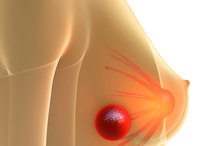Breast Stages in Puberty
Breast development often marks the beginning of puberty, and for many young girls and their parents, it can come as a bit of a surprise. Breast development in puberty may begin as early as 6 years of age 38. For girls in the United States, the entire breast development process generally occurs between about 8 to 13 years of age, according to “Gender Differences at Puberty.” Growth of the breasts can be described in steps, called Tanner stages, ranging from stage 1, representing no pubertal development, to stage 5 -- the fully developed, mature breast 18.
Stage 1, Stage 2 - Breast Buds
Stage 1 refers to the normal breast appearance prior to puberty -- that is, the presence of just a slightly raised nipple. With stage 2 comes breast budding, or elevation of the breast and nipple from the chest -- the first sign of puberty in 90 percent of girls, according to an August 2014 article in "BMC Womens Health." True breast buds -- as opposed to body fat distributed to the breasts -- first form as tender, firm lumps in the areas just under the nipples, each typically no larger than a quarter. On average, Stage 2 breast development occurs between about 8 and 10 years of age, according to a December 2013 study in “Pediatrics. 3”
- Stage 1 refers to the normal breast appearance prior to puberty -- that is, the presence of just a slightly raised nipple.
- With stage 2 comes breast budding, or elevation of the breast and nipple from the chest -- the first sign of puberty in 90 percent of girls, according to an August 2014 article in "BMC Womens Health."
Stage 3 - Enlargement
Signs of Breast Development
Learn More
While the ring of color around the center of the nipple -- called the areola -- may begin to widen in stage 2, further enlargement of the breast and areola occurs in stage 3. Breasts take on a conelike shape, and the areola may both enlarge and darken. At this point, the tissues of the breast and the internal duct system are developing, and the breast itself is growing. It’s normal for one breast to be larger than the other during initial growth. Breast size usually becomes more equal in a year or so. Stage 3 occurs at an average age of about 12, according to a January 2014 report in “Annals of Human Biology.”
- While the ring of color around the center of the nipple -- called the areola -- may begin to widen in stage 2, further enlargement of the breast and areola occurs in stage 3.
- At this point, the tissues of the breast and the internal duct system are developing, and the breast itself is growing.
Stage 4 - Areola Mounds
Stage 4 marks another period of growth. During this phase, the areola rises up from the rest of the breast to form a secondary mound. The nipple sits atop this mound. Tanner stage 4 generally occurs about 6 months after stage 3, according to the January 2014 “Annals of Human Biology” report. This is around the same time that menstruation begins -- at about 12 and 13 years of age.
- Stage 4 marks another period of growth.
- Tanner stage 4 generally occurs about 6 months after stage 3, according to the January 2014 “Annals of Human Biology” report.
Stage 5 - Mature Breasts
Breast Bud Development Signs
Learn More
At stage 5, the breast is considered fully developed and mature, with progression from the conical shape seen in stage 3 to a more rounded, mature shape. In some girls and women, the areola continues to form a secondary mound. In others, the areola becomes flat against the breast and only the nipple protrudes. Most girls reach stage 5 sometime between 12 to 14 years of age but the timing is quite variable. Despite reported averages and age ranges, it is important to remember that breast development occurs at a rate unique to each girl and can vary greatly among girls.
- At stage 5, the breast is considered fully developed and mature, with progression from the conical shape seen in stage 3 to a more rounded, mature shape.
Related Articles
References
- Gender Differences at Puberty; Chris Hayward, et al.
- BMC Women’s Health: Breast Bud Detection: A Validation Study in the Chilean Growth Obesity Cohort Study
- Pediatrics: Onset of Breast Development in a Longitudinal Cohort
- Johns Hopkins Medicine: Normal Breast Development and Changes
- American Academy of Pediatrics: Physical Development in Girls: What to Expect
- Annals of Human Biology: A Mixed Effects Model to Estimate Timing and Intensity of Pubertal Growth From Height and Secondary Sexual Characteristics
- Pediatric Endocrinology, Volume 2; Fima Lifshitz, et al.
- Seminars in Plastic Surgery: Development of the Human Breast
- Advanced Pediatric Assessment, Second Edition; Ellen M. Chiocca MSN, CPNP, APN, RNC-NIC
- Javed, A., and A. Lteif. Development of the Human Breast. Seminars in Plastic Surgery. 2013. 27(1):5-12.
- Love, Susan M., Elizabeth Love, and Karen Lindsey. Dr. Susan Love's breast book. Boston, MA: Da Capo Lifelong, 2015. Print.
- Zucca-Matthes, G., Urban, C., and A. Vallejo. Anatomy of the Nipple and Breast Ducts. Gland Surgery. 2016. 5(1):32-36.
Writer Bio
Based in Washington, D.C., C.J. Cochran graduated from Gettysburg College in 2013 with a Bachelor of Science in English and biology. She is working on her PhD in microbiology and immunology.







